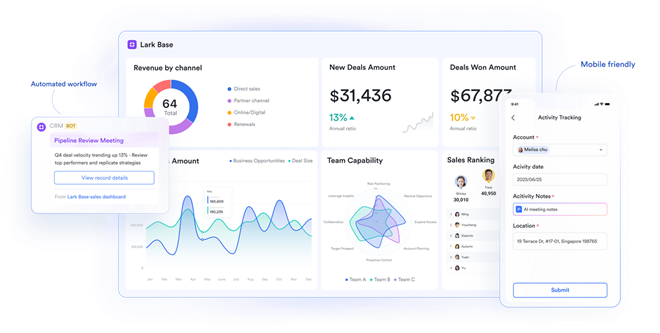Technology
Reimagining Collaboration: Why Businesses Need More Than Just CRM Software

For several years, customer relationship management tools have been at the core of how businesses operate. But currently, businesses need more than dot products; they need platforms to easily integrate communication, data, and collaboration.
While project management tools help track progress and tasks, they often lack the depth of connection teams need to truly work as one. That’s where Lark steps in—redefining collaboration with a workspace built to unify processes, people, and performance.
Lark Base: Powering data visibility and CRM
Lark Base provides a unified foundation for structured collaboration, enabling teams to manage customer relationships, sales pipelines, and operational workflows all in one platform. It turns simple databases into powerful CRM tools, allowing teams to track leads, manage deals, and automate routine tasks without relying on static spreadsheets or fragmented systems.
Key Features:
-
Create clear, visual databases to organize leads, opportunities, and customer interactions.
-
Customize workflows to match your sales process and team structure.
-
Automate follow-ups, reminders, and routine CRM tasks to keep deals moving.
-
Use Kanban boards, dashboards, and reporting to monitor pipeline health and team performance in real time.
-
Centralize customer data to gain a 360-degree view of each account and streamline decision-making.
With transparent, real-time data, teams can respond faster, collaborate more effectively, and manage customer relationships more intelligently. Lark Base goes beyond traditional CRM software, helping businesses achieve smarter, faster, and more human-centered sales and customer management.
Lark Messenger: Creating fluid, real-time collaboration
Communication is the key connector, and Lark Messenger connects teams quickly and effectively at every step. The intelligent, real-time messaging system replaces broken and fractured communication with rich-context conversations that’s connected directly to work.
Key features:
-
Instant messaging with individuals or groups across teams and geographies.
-
Threads for organized discussions with easy searching.
-
Share files, links, and tasks in the chat window.
-
Easily turn messages in to tasks in one click.
-
Simple collaboration while using chat, video calls, and Docs.
With Messenger, updates roll in, decisions are made faster, and collaboration feels easy.
Lark Calendar: Streamlining coordination across teams
Timing is crucial for effective collaboration. Lark Calendar integrates everyone’s schedules into one easy view to make it easy for teams to plan meetings, follow deadlines and meet timelines.
Key Features:
-
Calendar view of everyone’s schedules including individual and team calendars.
-
Scheduling with auto-availability and all timezones.
-
Document or task attachments to Calendar events for reference points.
-
Reminders and notifications of important project milestones – instant and extended.
-
Instant repurposing of scheduled meetings with re-communication on new priority.
Clearly, Calendar adds to the rhythm and coordination of enterprise across hybrid or global teams!
Lark Docs: Turning ideas into collective progress
Ideas develop more quickly when the whole team participates. Lark Docs turns traditional documentation into a living collaboration space where teams can co-author, comment on, and improve ideas in real time.
Key features:
-
Collaborate with your team on documents simultaneously.
-
Offer quick feedback inline with comments and suggestions.
-
Incorporate tables, charts and media into your writing.
-
Organize shared documents into folders for quick access.
-
Connect your docs directly to tasks, chats & events.
Docs helps teams convert raw ideas to executable strategies everyone can act on.
Lark Tasks: Keeping accountability visible and progress measurable
Accountability makes collaboration lead to results. Lark Tasks clearly defines responsibility, builds visibility of progress, and clarifies deadlines without micromanaging.
Key features:
-
Assign tasks which have deadlines, priority, and description.
-
Track the status in a customizable view (list, board or timeline).
-
Link tasks to conversations or documents to provide context.
-
Get automated updates about progress and overdue.
-
Filter tasks by project, owner, or progress.
Tasks allow for alignment and consistency—keeping everyone accountable and lessening the need for communications.
Lark Meetings: Humanizing digital collaboration
Working together means more than efficiency. Lark Meetings delivers clear human connection for remote workers using video conferencing, shared agendas, and live notes.
Key Features:
-
Start high-definition video meetings with screen sharing
-
Produce shared agendas and write live notes in the meeting
-
Easily move from chat to video when needing to discuss
-
Record and save meetings to refer to if needed after the call
-
Assign follow up work from notes in the meeting
With Meetings, digital collaboration feels as real as working together in person, promoting trust, even when working remotely.
Lark Sheets: Turning data into collaborative intelligence
Data gains strength through sharing. Lark Sheets allows teams to use data simultaneously by editing, analyzing, or discussing number all in real time.
Key features:
-
Edit spreadsheets together with auto-sync.
-
Consult formulas and live graphs for immediate analysis.
-
Build dashboards to track KPIs and project health.
-
Comment directly in the cell for clarification on any data point.
-
Integrate Sheets with all tools in Lark to provide full visibility.
Sheets puts teams in the position of being collaborative informed decision makers rather than working in silos.
Lark Wiki: Building a culture of shared knowledge
Silos reduce collaboration and the sharing of knowledge enhances it. Lark Wiki provides a structured and searchable library of company knowledge, policies, and best practices.
Key features include:
-
Create structured pages for processes, FAQs, and onboarding.
-
Link content from the Wiki to Docs, tasks, or databases.
-
Tag and categorize content for easier access.
-
Have a version history of content that has been updated.
-
Allow every employee access to institutional knowledge.
Wiki makes sure that collaboration doesn’t end when a project ends; it becomes part of the collective capacity growth of the company.
Lark Approval: Simplifying decision-making with clarity
Effective decision-making drives team collaboration forward. Lark Approval streamlines internal processes so that teams can respond to requests and reviews in pace, transparency, and without lag.
Key highlights:
-
Easily automate routine requests like leave, purchases, and expenses.
-
Set up approval routes and resourcing reviewers simply.
-
Monitor tracking and notifications in real-time.
-
Approvals are recorded and can be searched.
-
Stop bottlenecks and ensure organizational consistency.
With Approval, businesses can remain agile, compliant, and organized.
Lark OKR: Aligning collaboration with company goals
Effective collaboration takes place when there is a consensus on a purpose. Lark OKR connects daily team work to long-term interval objectives – keeping motivation high and directional clarity.
Some key functions include:
-
Create organization-wide OKRs as well as team-level OKRs.
-
Capture tangible results in real time.
-
Use a dashboard and reporting to reflect results.
-
Connect objectives with project tasks.
-
Celebrate success to boost morale and engagement.
OKR helps organizations make sure that collaboration is intentional, and more than just busy-work.
Lark Mail: Keeping communication professional and contextual
Formal communication continues to be a vital part of collaboration. Lark Mail allows our customer communications and partnership conversations to stay in the same workspace as our internal team collaboration.
Key features include:
-
Access your business emails in a clean, easy-to-use interface.
-
Relate emails to Docs, tasks, or meetings to put them into context.
-
Search past conversations effortlessly with smart filters.
-
Stay professional with shared templates and shared signatures.
-
Have a communication history tied to specific project records, if applicable.
Mail connects formal and informal communication and give teams the ability to be both efficient and aligned.
Conclusion: Beyond CRM—building connected collaboration that lasts
CRM systems are excellent for managing customer relationships, but they often stop short of enabling the deeper collaboration that drives long-term success. Lark bridges that gap, offering a unified workspace that keeps communication, data, and decision-making connected across every level of an organization.
Supporting the workflow of modern CRM app and the features of project management tools, Lark helps businesses move from managing information to mastering collaboration. Here, they can build teams that are not just productive, but cohesive, adaptable, and ready for the future of work.




